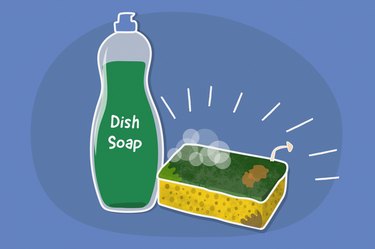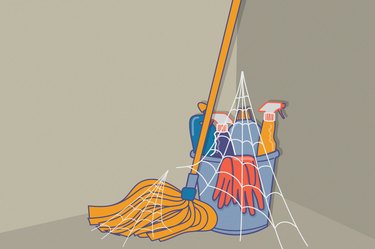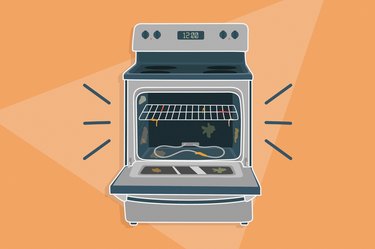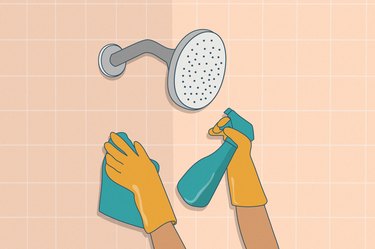
A sponge is your wingman in the quest to make your kitchen sparkling and germ-free, right? So you might be surprised to discover that it's actually the dirtiest thing in your house.
A July 2017 study in Nature found that sponges are teeming with germs. In samples from 14 sponges, researchers identified 362 different types of bacteria. The only other place with this much bacteria is the human intestinal tract.
Video of the Day
Video of the Day
Moreover, an April 2017 study in the Journal of Food Protection determined that 44 percent of kitchens contained fecal bacteria, which was primarily found in sinks, sponges and dishcloths.
If it's been forever since you sanitized your sponge or swapped it out for a new one, your stomach is probably crawling right about now. Here's why you should be concerned — and how to clean up your act.
Why Do Kitchen Sponges Harbor So Many Germs?
It's a dirty job, but your sponge has to do it.
"Your kitchen sponges get used to clean all of the dirty crockery, including knives and chopping boards that may have been in contact with raw meat or other contaminants," says Henry Paterson, operations executive at Housekeep. "Not to mention, many of us use the sponge to clean counters and spills."
On top of that, the design of a sponge makes it a hotspot for bacteria. "Sponges are porous and are rarely dry fully between uses," Paterson says. "Since bacteria thrive in warm, damp environments, a sponge provides the ideal conditions for germs to multiply."
Finally, your sponge MO can contribute to the growth and spread of pathogens. "Some people lack an understanding of the dynamic at play," says Philip Tierno, PhD, clinical professor of microbiology and pathology at NYU Langone Health.
"If you clean raw chicken drippings with a sponge, it will pick up microorganisms that may have been growing in the chicken juice; the next time you use the germ-ridden sponge, you will cross-contaminate the kitchen."
As you proceed to wipe off the countertops, fridge handle and faucet, you're effectively smearing those pathogens all over the room.
"Your risk of illness increases the more cavalier you are about sponge hygiene, but it is not a quid pro quo. It depends on the strength of your immune system, the number of bacteria you ingest and the type of bacteria — certain kinds are more virulent than others."
An Old, Filthy Sponge Could Give You Food Poisoning
An estimated 48 million people get sick from a foodborne illness every year, according to the Centers for Disease Control and Prevention (CDC). The biggest bacterial and viral offenders are norovirus, salmonella, C. perfringens, campylobacter and staph.
For most folks, food poisoning results in a night praying to the porcelain gods — think: nausea, vomiting, cramps and diarrhea. But you could be in deeper trouble. Per the CDC, 128,000 people end up being hospitalized for foodborne illness annually. Older adults, children and those who are pregnant or immunocompromised are at greater risk.
That said, you might get lucky: The microorganisms multiplying on your sponge might not be the kind that make you sick — the majority of bacteria in the July 2017 Nature study were not harmful to most people.
It's also possible that the food droppings you wiped up might be germ-free, although the odds aren't in your favor if the sponge has been in contact with uncooked poultry. Tierno points out that about 80 to 90 percent of raw chicken contains some sort of pathogen.
"Your risk of illness increases the more cavalier you are about sponge hygiene, but it is not a quid pro quo," Tierno says. "It depends on the strength of your immune system, the number of bacteria you ingest and the type of bacteria — certain kinds are more virulent than others."
The One Time You Need to Replace Your Sponge
Even though grungy sponges are bursting with germs, you don't actually need to stock up on Costco-sized packages of Scotch-Brite.
"The kitchen sponge never has to be replaced except for one circumstance: when it becomes functionally unusable," Tierno says. "If it's shredding and not picking up liquid, you should get a new one."
The most important thing is to sanitize your sponge on a daily basis. As long as it's squeaky-clean, you're in the clear.
3 Ways to Disinfect Your Sponge
These easy methods will demolish germs.
In a Bleach Solution
Tierno's favorite sterilization strategy is to mix 1 ounce of bleach with 1 quart of water. Dip your sponge in and let it sit for 2 minutes. Then, rinse off the sponge with soap and water, and let it air-dry.
"This will quickly kill any foodborne germs," Tierno says. "And the bleach will soon dissipate, so it's not harmful to the environment."
In the Microwave
Put the sponge in a bowl of water and nuke it until it reaches a boiling point. Microwaves don't heat uniformly, so if you just put the sponge on a dish, areas might be missed and it won't efficiently kill all the microorganisms.
"The bowl of water ensures a uniform ambient temperature, which guarantees that all the pathogens will be killed," Tierno says.
Warning
Never microwave a dry sponge or one that contains metal — it’s a fire hazard.
In the Dishwasher
If your dishwasher has a germicide cycle, pop your sponge in to disinfect it. The high heat zaps pathogens.
4 Sponge Safety Tips
Follow these tips from the Academy of Nutrition and Dietetics to help keep your scrubber spick and span.
1. To cut down on contamination, clean up raw poultry and meat juice with a disposable paper towel instead of a sponge.
2. Consider using your sponge only for dishwashing. Stick to paper towels plus a sanitizing spray or disinfecting wipes for countertops. Or switch to fast-drying microfiber cloths. A dry environment is less hospitable to pathogens, and microfiber cloths are easy to clean — throw them in hot water in the washing machine and dry on high heat.
3. Wring out your sponge well after each use and store it in an airy location where it's easy to dry, like a sponge caddy attached to the side of your sink or dish drainer.
4. If your sponge has a stench even after sanitizing it, toss it.
So, Is Never Replacing Your Sponge Really That Bad?
The big takeaway here is that disinfecting your sponge on the reg is paramount. Remember, you can disinfect your sponge in the microwave, in the dishwasher or in a bleach solution.
"As long as sanitation occurs every day, it's not bad to never replace your sponge," Tierno says.
- Nature: "Microbiome analysis and confocal microscopy of used kitchen sponges reveal massive colonization by Acinetobacter, Moraxella and Chryseobacterium species"
- CDC: "Foodborne Germs and Illnesses"
- Academy of Nutrition and Dietetics: "Are Your Kitchen Surfaces and Sponges Really Clean?"
- Journal of Food Protection : "Prevalence of Pathogens and Indicator Organisms in Home Kitchens and Correlation with Unsafe Food Handling Practices and Conditions "
Was this article helpful?
150 Characters Max
0/150
Thank you for sharing!
Thank you for your feedback!



